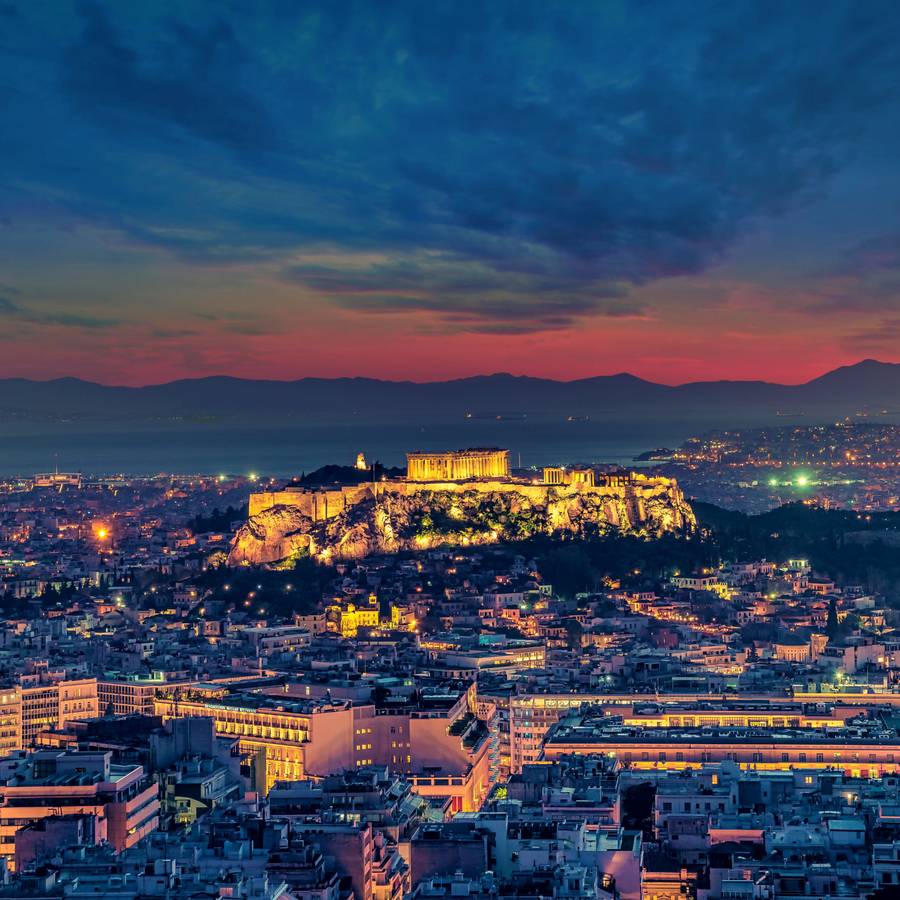What's the difference between the Acropolis and Parthenon?

The Acropolis is the overall archaeological site—a fortified hill in Athens containing several ancient structures. The Parthenon, on the other hand, is a specific ancient temple situated on the Acropolis, dedicated to the goddess Athena. The Parthenon is just one of the several important structures on the Acropolis
The Acropolis is a large fortified hill located in the center of Athens. It is one of the most important archaeological sites in Greece and holds significant historical and cultural value. The Acropolis served as the citadel of ancient Athens, and it was a religious, cultural, and political center of the city. The word "Acropolis" comes from the Greek words "akro" (meaning high or extreme) and "polis" (meaning city), so it can be translated as "high city."
The Acropolis is home to several ancient structures, the most famous of which is the Parthenon. Other notable buildings on the Acropolis include the Erechtheion, the Temple of Athena Nike, and the Propylaea (the monumental gateway to the Acropolis) andThe Odeon of Herodes Atticus.
The Parthenon is a specific ancient temple that stands on the Acropolis. It was built in the 5th century BCE and is considered one of the most iconic examples of ancient Greek architecture. The temple was dedicated to the goddess Athena, who was the patron deity of Athens and the city's protector.
The Parthenon is a Doric-style temple with impressive columns and intricate architectural details. It was constructed under the supervision of the renowned architects Ictinus and Callicrates, and the sculptural work on the temple, including the famous frieze depicting various scenes from Greek mythology, was overseen by the sculptor Phidias.
How long does it take to walk up to the Parhenon
The time it takes to walk up to the Parthenon on the Acropolis can vary depending on several factors, such as your starting point, fitness level, and the pace of your walk. On average, it takes approximately 15 to 20 minutes to ascend from the main entrance at the southwest slope of the Acropolis to the Parthenon itself. This duration may be slightly longer if you choose to take your time, explore other structures on the Acropolis, or if there are crowds that slow down your progress. However, it's a relatively short and enjoyable walk, and once you reach the top, you'll be rewarded with a breathtaking view of Athens and the magnificent ancient temple, the Parthenon.
Is the Parthenon free to visit?
To visit the Acropolis you will have to purchase a ticket. There are two ticket options for entrance into the Acropolis and Parthenon. You can purchase a ticket for entrance only into the Acropolis or you can purchase a combination ticket into the Acropolis plus six more archaeological sites.
There are specific days throughout the year when you can enter the Acropolis for free. These days include March 6, April 18, May 18, the last weekend of September, October 28, and every Sunday from November 1 to March 31.
Is The Acropolis open every day?
The Acropolis will is closed on these days: January 1, March 25, May 1, Easter Sunday, December 25, December 26.
The Athens Acropolis is open daily from 8 AM to 8 PM during the summer months (April to October). The last entry is allowed until 7:30 PM. In the winter months (November to March), the sites close earlier, at 5 PM, with the last entry permitted until 4:30 PM.
It's always a good idea to buy your ticket online here
Does Acropolis ticket include Parthenon?
Yes, the Acropolis ticket includes access to the Parthenon. When you purchase a ticket to visit the Acropolis, it grants you entry to all the major archaeological sites on the Acropolis hill, including the Parthenon, the Erechtheion, the Temple of Athena Nike, the Propylaea, and other areas within the site.
The Parthenon is one of the main attractions on the Acropolis and is considered a highlight of any visit to Athens. As the most iconic ancient temple in Greece, the Parthenon draws visitors from around the world who come to admire its architectural beauty and historical significance.
Remember to check the most recent information about ticket prices, possible discounts, and any changes in entry policies before planning your visit to the Acropolis and the Parthenon. This way, you can ensure a smooth and enjoyable experience exploring these remarkable ancient structures.
Are the Parthenon and Acropolis close to each other?
Yes, the Parthenon and the Acropolis are very close to each other as they are essentially part of the same archaeological site in Athens, Greece.
The Acropolis is a large fortified hill in the center of Athens, and it houses several ancient structures, including the Parthenon. The Parthenon is located on top of the Acropolis and is one of the most prominent and iconic buildings on the hill.
When you visit the Acropolis, you'll have the opportunity to see the Parthenon up close, along with other significant structures like the Erechtheion, the Temple of Athena Nike, and the Propylaea (the monumental gateway). All of these ancient landmarks are situated within a relatively small area on the Acropolis hill, making it easy to explore them in one visit.
Due to their proximity, visitors can experience the historical and architectural wonders of both the Acropolis and the Parthenon in a single tour, providing a deep appreciation for the rich history and cultural heritage of ancient Athens.
Is Pantheon same as Acropolis?
No, the Pantheon is not the same as the Acropolis. They are two distinct and separate historical sites, located in different cities and with different historical backgrounds. The Acropolis is an ancient site in Athens, Greece, while the Pantheon is an ancient temple in Rome, Italy. Both are significant historical and cultural landmarks, but they are located in different cities and represent different ancient civilizations.
The Acropolis is an ancient fortified hill located in Athens, Greece. It was a religious, cultural, and political center of the city in ancient times. The word "Acropolis" comes from the Greek words "akro" (meaning high or extreme) and "polis" (meaning city), so it can be translated as "high city."
The Pantheon is an ancient Roman temple located in Rome, Italy. It was originally commissioned during the reign of the Roman emperor Augustus and later rebuilt by the emperor Hadrian in the 2nd century AD. The term "Pantheon" comes from the Greek words "pan" (meaning all) and "theos" (meaning gods), so it can be translated as "all the gods."
Is Acropolis and Acropolis Museum the same?
No, the Acropolis and the Acropolis Museum are not the same. They are two separate but closely related sites in Athens.
The Acropolis is the ancient hilltop site that houses several historical structures, while the Acropolis Museum is a modern museum located nearby, dedicated to exhibiting the archaeological finds from the Acropolis. Both are must-visit destinations for anyone interested in Greek history and culture.
The Acropolis is an ancient fortified hill located in the center of Athens. It is one of the most important archaeological sites in Greece and a UNESCO World Heritage Site. The Acropolis was the religious, cultural, and political center of ancient Athens and houses several significant ancient structures, including the Parthenon, the Erechtheion, the Temple of Athena Nike, and the Propylaea (the monumental gateway). The Acropolis offers breathtaking views of Athens and is a popular destination for tourists and history enthusiasts.
The Acropolis Museum is a modern museum located at the southeastern slope of the Acropolis hill, near the entrance to the archaeological site. It was built to house and display the artifacts and sculptures found on the Acropolis and its surrounding area. The museum showcases a wide range of ancient Greek art and artifacts, including the original marbles from the Parthenon and other temples on the Acropolis. It provides visitors with valuable insights into the history and significance of the Acropolis and its architectural wonders.
Why is the Acropolis so special?
The Acropolis is a testament to the achievements of ancient Greek civilization and a cherished cultural heritage that continues to inspire and captivate people worldwide.
The Acropolis is considered so special and iconic for several reasons:
- Historical Significance: The Acropolis has a rich and ancient history that dates back to the 5th century BCE. It served as the religious and cultural center of ancient Athens and was the site of many important events in Greek history.
- Architectural Marvels: The Acropolis is home to some of the most remarkable examples of ancient Greek architecture. The Parthenon, in particular, is celebrated for its Doric style, exquisite design, and precision in construction. The buildings on the Acropolis showcase the pinnacle of ancient Greek architectural achievements.
- Symbol of Democracy: The Acropolis represents the birthplace of democracy. It was the location of important gatherings and assemblies where democratic decisions were made in ancient Athens.
- Artistic Heritage: The Acropolis houses an extensive collection of ancient Greek art and sculpture. The magnificent sculptures and friezes that adorned the temples are known for their beauty and artistic mastery.
- Influence on Western Civilization: The culture and achievements of ancient Greece, exemplified by sites like the Acropolis, have had a profound influence on Western civilization, shaping art, philosophy, politics, and more.
- UNESCO World Heritage Site: The Acropolis was designated as a UNESCO World Heritage Site in 1987, recognizing its outstanding cultural and historical value to humanity.
- Panoramic Views: Perched on a hill, the Acropolis offers stunning panoramic views of Athens, allowing visitors to appreciate the city's beauty and layout.
- Preservation Efforts: The Acropolis has undergone extensive preservation and restoration work to protect its ancient structures and artifacts for future generations.
- Tourism and Cultural Attraction: The Acropolis attracts millions of visitors from around the world, making it one of the most popular tourist destinations in Greece.
- Cultural Identity: The Acropolis is a symbol of Greek cultural identity and a point of pride for the people of Greece.
Is there a visitor limit at the Acropolis?
According to safety measurements by the Ministry of Culture, the maximum number of visitors per day at the Acropolis should not exceed 23,000, with an ideal cap at 21,000 people.
- In the morning hours, from 8:00 AM to 12:00 PM (peak hours with cruise ship arrivals), four hourly visitation zones have been established, allowing a total of 8,000 visitors.
- In the afternoon, from 12:00 PM to 8:00 PM, eight hourly zones are in place, allowing for 13,000 visitors.
When the maximum capacity for each zone is reached, ticket sales will be suspended. For reservations, you can visit hhticket.gr.

